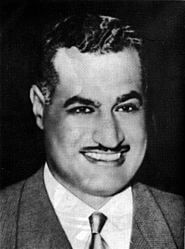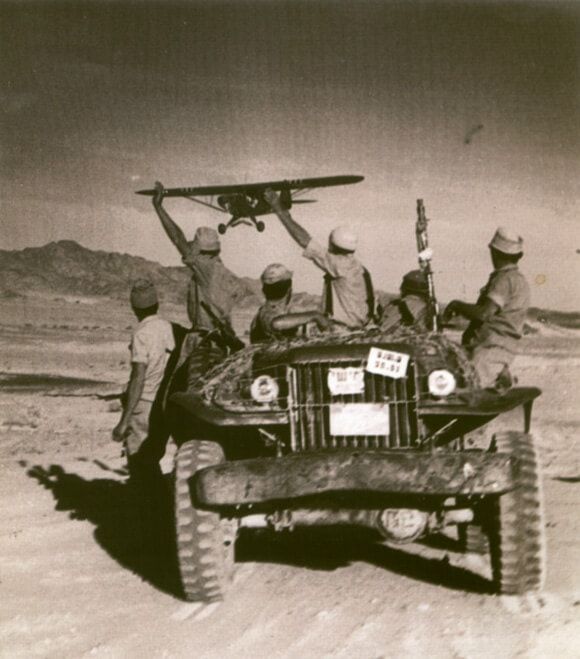The armistice agreements which Israel signed with its Arab neighbors in 1949 following the War of Independence did not bring quiet to the citizens of the new state. And while most have heard of the famous wars such as the Six Day War in 1967 and the Yom Kippur War in 1973, Israel had to fight for its survival much sooner after 1948 than that in the buildup to its 1956 Sinai Campaign.
Two significant developments kept Israel in a constant state of war following the achievement of its independence. The first related to the Soviet Union which became one of Israel’s staunchest enemies for two reasons – Stalin’s antisemitism and Israel’s move away from establishing a communist government. The second related to the change of leadership in Egypt. King Farouk was removed from power in a military coup officially led by Colonel Mohammed Naguib but, in reality, driven by a captain named Gamal Abdel Nasser, who became the new Egyptian leader.

Nasser gave serious thought to making peace with Israel. That would enable his country to focus on becoming the strong, modern, socialist country that he envisioned. But he also dreamt of being the leader of the entire Arab world across the entire Middle East. In order to accomplish that goal and be accepted as THE Arab leader, he had to show strength and take a harsh stance against Israel. Thus, his path to “greatness” meant promoting violence and waging war against Israel.
Nasser’s dream of building Egypt and being seen as a great leader led him to act to take control of the Suez Canal, with an ultimate plan to build a dam to regulate the river, prevent flooding, and give Egypt the irrigation and hydro-electric power that could make it an extremely wealthy country. Of course, the Suez Canal being under Egyptian control would also be a great source for Egyptian pride.
Join the fight for Israel’s fair coverage in the news
Nasser believed he could count on the United States for assistance with wrestling control of the canal from the British and with the finances of the project. But when the US turned him down, Nasser turned to the Soviets for help. The Soviet Union not only helped finance the project but also gave Egypt weapons for its army alongside military advisers to train the Egyptian military. Backed by the Soviet Union, Nasser evicted Britain from the Suez Canal with ease, declared it a possession of Egypt, and quickly gained fame and supremacy as a leader in the Arab world.
Armed with his alliance with the Soviet Union which was already anti-Israel, and with the sights of the Arab world upon him, Nasser quickly turned to confront Israel.
Instead of attacking Israel with his full army, Nasser came up with a tactic which is still being used against Israel today. In the early 1950s, not long after Israel thought it could enjoy a respite from the War of Independence, he organized, armed and supported terrorists, called “Fedayeen,” to cross the border and terrorize Israelis – blowing up farms, planting land mines, and even entering schools to shoot Jewish children. The philosophy was to attack, hurt and demoralize Israel without starting an actual war. Israel would have no choice but to retaliate and that retaliation would be the justification for the next terror attack as retribution for Israel’s actions. This created a “cycle of violence” which cost Israel in lives, money, and focus, and served Nasser’s plan of partnering with the Soviet Union and showing the Arab world his strength.
Egypt was not Israel’s only problem following the War of Independence. The Syrians continuously shelled northern Israeli towns from the Golan Heights, forcing Israelis to sleep in bunkers and leaving Israel with no choice but to respond – continuing the cycle of violence. Jordanian snipers would regularly shoot at Jewish civilians from the Old City of Jerusalem which they controlled. Israel even had to construct its residential buildings with no windows facing the Jordanian controlled areas.
Thus, the new Jewish state was under a continuous state of attack and to make things even worse, when Israel would respond – against Egypt, Syria, or Jordan – the United Nations would condemn Israel for instigating violence and inflaming the region.
Jordan’s King Abdullah I indicated that he was prepared to negotiate with Israel and explore a peace agreement. But Nasser and other Arab leaders forced him not only to pull back from those efforts but to make his opposition to peace public. Abdullah came out with a series of declarations such as:
Peace with Israel is unthinkable. The Arabs will not agree to peace as long as the Jews live in the heart of the Arab states, sowing unrest and fear in our midst. Our first round, unfortunately, was unsuccessful. There is no doubt that the Arabs will prepare for a second round with all their energy and be successful.
Despite this strong anti-Israel rhetoric, King Abdullah was assassinated in 1951 outside of the Al Aqsa mosque while leaving Friday prayers by a Palestinian extremist angry over the fact that he ever considered peace with Israel. This precedent no doubt influenced other Arab leaders in the region and would make it almost impossible for any of them to consider making peace with Israel.
Nasser made sure to take part in the anti-Israel rhetoric. He went as far at telling the New York Post that his fight was not only with Israel but that he was fighting against Jews around the world and the ‘Jewish wealth’ which ‘oppresses mankind everywhere.’
The act of aggression which broke the straw on the camel’s back for Israel was his closing of the Suez Canal to Israeli shipping. This cut Israel off from shipping to Europe and the western world and was a step which Israel could not tolerate. Israel had made it clear that this would be treated as a casus belli (cause of war) and needed to respond with something much greater than the small-scale responses to Egyptian-led terror attacks.
Israel turned to two countries for assistance: Britain, which was still angry over losing control of the Suez Canal, and France, which was fighting its own war against Arabs in Algeria. The three countries came up with a plan. Israel would launch a Sinai Campaign to invade Egyptian controlled areas and move towards the Canal. Britain and France would call on Israel to stop their advance and would volunteer to send their navies and armies to the Canal in order to keep the peace between the two sides. Thus, the British would regain control of the Canal and allow Israel to use it, and Nasser’s power would be diminished.
Israel’s Sinai Campaign began in October 1956. The IDF forced the Egyptian army to retreat and moved quickly through the Sinai and Gaza. After four days Israel was just 18 miles away from the Suez Canal and it took them just six days to reach Sharm el-Sheikh at the southern border of the Sinai. British and French soldiers parachuted into the Suez area and defeated the Egyptian troops there. But Nasser, whose power was on the verge of collapse, didn’t fold and ordered his ships to block the Canal.

Then, something shocking occurred. The United States joined together with the Soviet Union and demanded that Israel, Britain and France withdraw their forces from the Canal. Apparently, the US was upset that they were not told about this plan in advance by its allies. The US even led the way for a UN General Assembly vote on the issue. Israel had no choice but to withdraw its forces from the Sinai – with a promise from the UN to protect its southern border – and Nasser emerged as a hero in his own country and the Arab world.
While the Sinai Campaign did curb the terror attacks coming from Egypt towards Israel with the UN force preventing fedayeen from entering Israel, the Jewish state still continued to suffer constant terror attacks by Arabs, especially following the establishment of the Palestinian Liberation Organization in 1964 and the operations of its Fatah wing which began on January 1, 1965. Israel also experienced constant strife from Syria, which tried to thwart Israel’s National Water Project and attempted to divert the waters of the Jordan River which originate in Syria. Israel had to use military force to confront these challenges and thwart these efforts.
Fortunately for Israel, Nasser sent his troops to support a rebellion in Yemen which lasted close to seven years, and Israel was no longer his focus. But the failure of that war, in which Egypt lost tens of thousands of soldiers, left the Arab world angered with Israel. That error along with his failed attempt to take over Syria, left Nasser in bad shape politically and economically and it was only a matter of time before he turned his sights towards Israel.
Liked this article? Follow HonestReporting on Twitter, Facebook, Instagram and TikTok to see even more posts and videos debunking news bias and smears, as well as other content explaining what’s really going on in Israel and the region. New! Skip the social scroll and get the latest from HonestReporting via Telegram.

